Financial Analysis of Management Accounting Report and Techniques
VerifiedAdded on 2021/02/19
|27
|7693
|20
Report
AI Summary
This report provides a comprehensive overview of management accounting, encompassing various aspects such as cost accounting systems, price optimization, job costing, and inventory management. It delves into different types of accounting reports, including performance reports, budget reports, and accounts receivable aging reports, and explores the purpose of these reports in aiding organizational decision-making. The report further examines appropriate cost analysis techniques for preparing income statements, emphasizing the importance of relevant and accurate information. Additionally, it discusses the advantages and disadvantages of planning tools used for budgetary control and analyzes how organizations adapt management accounting systems to address financial challenges, drawing comparisons between different companies. The report concludes by highlighting measures to overcome financial issues, providing a well-rounded perspective on the significance and application of management accounting principles.
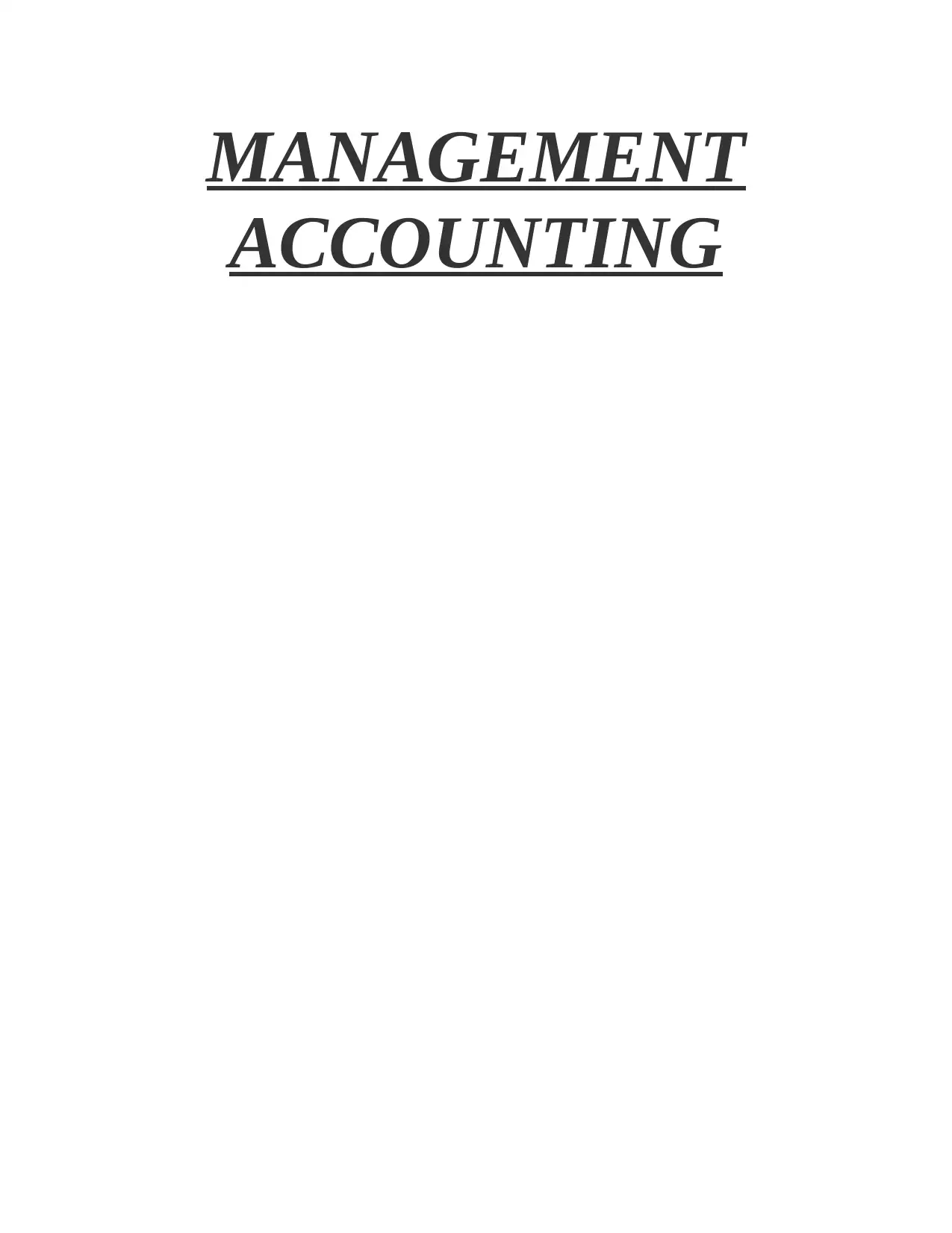
MANAGEMENT
ACCOUNTING
ACCOUNTING
Paraphrase This Document
Need a fresh take? Get an instant paraphrase of this document with our AI Paraphraser
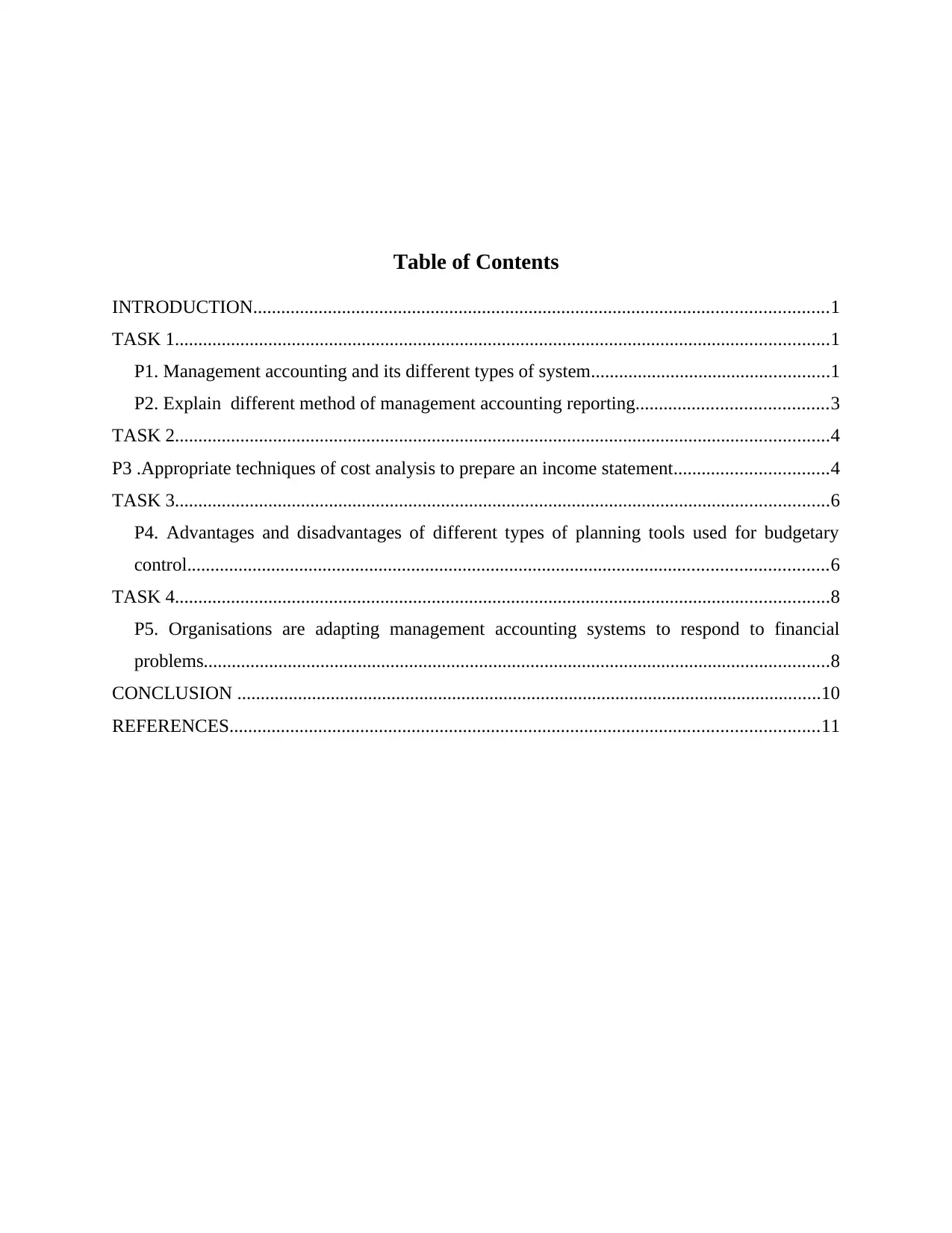
Table of Contents
INTRODUCTION...........................................................................................................................1
TASK 1............................................................................................................................................1
P1. Management accounting and its different types of system...................................................1
P2. Explain different method of management accounting reporting.........................................3
TASK 2............................................................................................................................................4
P3 .Appropriate techniques of cost analysis to prepare an income statement.................................4
TASK 3............................................................................................................................................6
P4. Advantages and disadvantages of different types of planning tools used for budgetary
control.........................................................................................................................................6
TASK 4............................................................................................................................................8
P5. Organisations are adapting management accounting systems to respond to financial
problems......................................................................................................................................8
CONCLUSION .............................................................................................................................10
REFERENCES..............................................................................................................................11
INTRODUCTION...........................................................................................................................1
TASK 1............................................................................................................................................1
P1. Management accounting and its different types of system...................................................1
P2. Explain different method of management accounting reporting.........................................3
TASK 2............................................................................................................................................4
P3 .Appropriate techniques of cost analysis to prepare an income statement.................................4
TASK 3............................................................................................................................................6
P4. Advantages and disadvantages of different types of planning tools used for budgetary
control.........................................................................................................................................6
TASK 4............................................................................................................................................8
P5. Organisations are adapting management accounting systems to respond to financial
problems......................................................................................................................................8
CONCLUSION .............................................................................................................................10
REFERENCES..............................................................................................................................11

⊘ This is a preview!⊘
Do you want full access?
Subscribe today to unlock all pages.

Trusted by 1+ million students worldwide
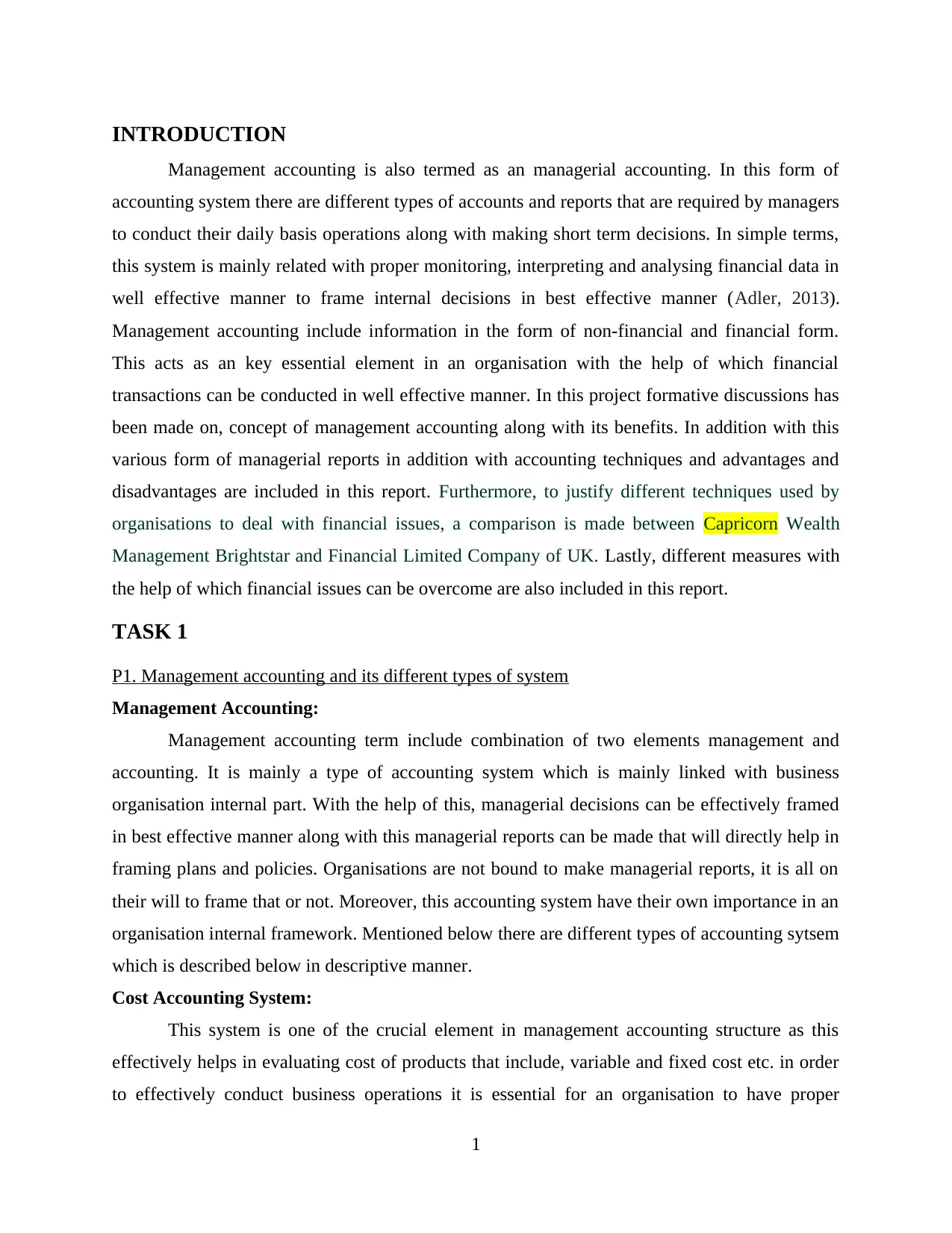
INTRODUCTION
Management accounting is also termed as an managerial accounting. In this form of
accounting system there are different types of accounts and reports that are required by managers
to conduct their daily basis operations along with making short term decisions. In simple terms,
this system is mainly related with proper monitoring, interpreting and analysing financial data in
well effective manner to frame internal decisions in best effective manner (Adler, 2013).
Management accounting include information in the form of non-financial and financial form.
This acts as an key essential element in an organisation with the help of which financial
transactions can be conducted in well effective manner. In this project formative discussions has
been made on, concept of management accounting along with its benefits. In addition with this
various form of managerial reports in addition with accounting techniques and advantages and
disadvantages are included in this report. Furthermore, to justify different techniques used by
organisations to deal with financial issues, a comparison is made between Capricorn Wealth
Management Brightstar and Financial Limited Company of UK. Lastly, different measures with
the help of which financial issues can be overcome are also included in this report.
TASK 1
P1. Management accounting and its different types of system
Management Accounting:
Management accounting term include combination of two elements management and
accounting. It is mainly a type of accounting system which is mainly linked with business
organisation internal part. With the help of this, managerial decisions can be effectively framed
in best effective manner along with this managerial reports can be made that will directly help in
framing plans and policies. Organisations are not bound to make managerial reports, it is all on
their will to frame that or not. Moreover, this accounting system have their own importance in an
organisation internal framework. Mentioned below there are different types of accounting sytsem
which is described below in descriptive manner.
Cost Accounting System:
This system is one of the crucial element in management accounting structure as this
effectively helps in evaluating cost of products that include, variable and fixed cost etc. in order
to effectively conduct business operations it is essential for an organisation to have proper
1
Management accounting is also termed as an managerial accounting. In this form of
accounting system there are different types of accounts and reports that are required by managers
to conduct their daily basis operations along with making short term decisions. In simple terms,
this system is mainly related with proper monitoring, interpreting and analysing financial data in
well effective manner to frame internal decisions in best effective manner (Adler, 2013).
Management accounting include information in the form of non-financial and financial form.
This acts as an key essential element in an organisation with the help of which financial
transactions can be conducted in well effective manner. In this project formative discussions has
been made on, concept of management accounting along with its benefits. In addition with this
various form of managerial reports in addition with accounting techniques and advantages and
disadvantages are included in this report. Furthermore, to justify different techniques used by
organisations to deal with financial issues, a comparison is made between Capricorn Wealth
Management Brightstar and Financial Limited Company of UK. Lastly, different measures with
the help of which financial issues can be overcome are also included in this report.
TASK 1
P1. Management accounting and its different types of system
Management Accounting:
Management accounting term include combination of two elements management and
accounting. It is mainly a type of accounting system which is mainly linked with business
organisation internal part. With the help of this, managerial decisions can be effectively framed
in best effective manner along with this managerial reports can be made that will directly help in
framing plans and policies. Organisations are not bound to make managerial reports, it is all on
their will to frame that or not. Moreover, this accounting system have their own importance in an
organisation internal framework. Mentioned below there are different types of accounting sytsem
which is described below in descriptive manner.
Cost Accounting System:
This system is one of the crucial element in management accounting structure as this
effectively helps in evaluating cost of products that include, variable and fixed cost etc. in order
to effectively conduct business operations it is essential for an organisation to have proper
1
Paraphrase This Document
Need a fresh take? Get an instant paraphrase of this document with our AI Paraphraser
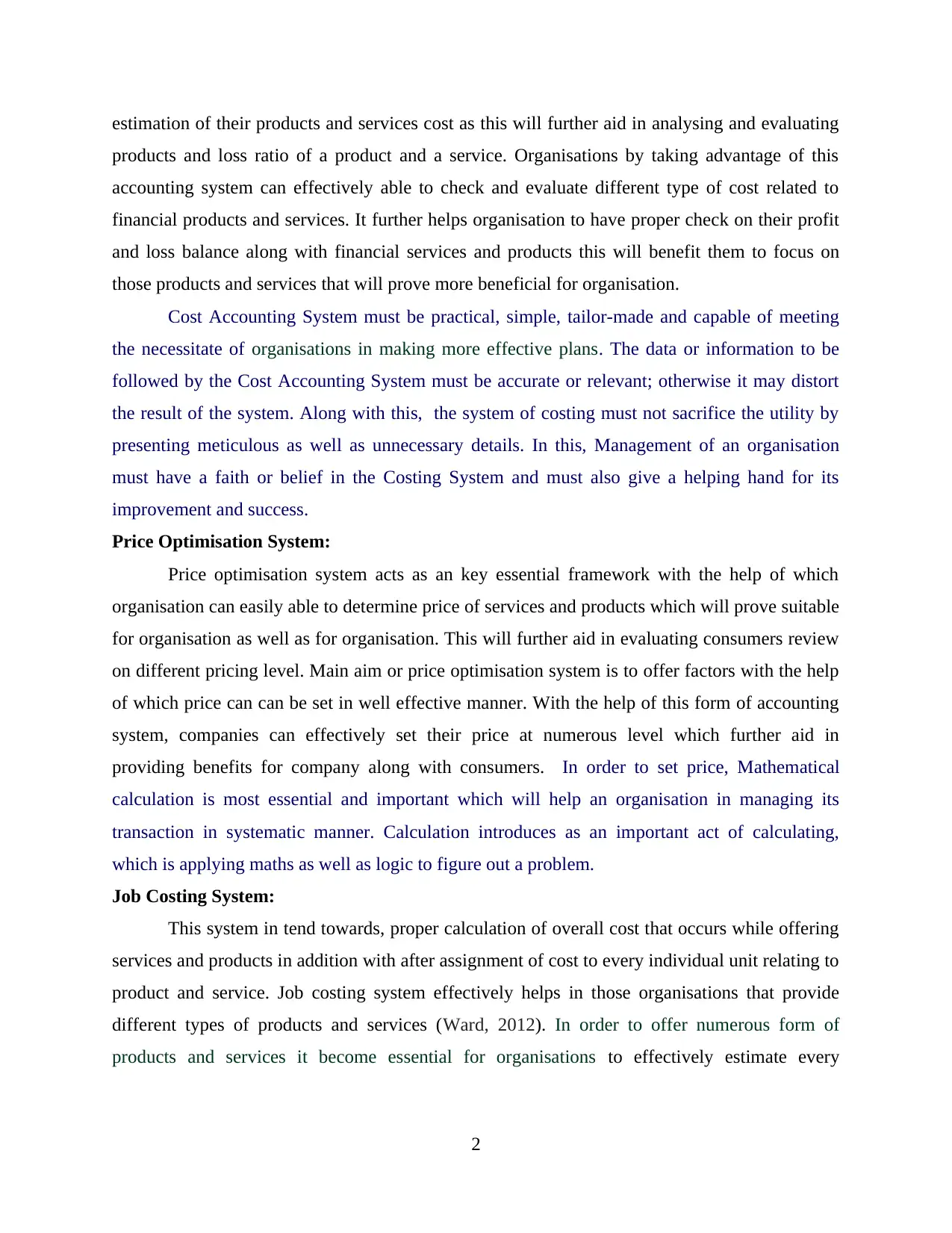
estimation of their products and services cost as this will further aid in analysing and evaluating
products and loss ratio of a product and a service. Organisations by taking advantage of this
accounting system can effectively able to check and evaluate different type of cost related to
financial products and services. It further helps organisation to have proper check on their profit
and loss balance along with financial services and products this will benefit them to focus on
those products and services that will prove more beneficial for organisation.
Cost Accounting System must be practical, simple, tailor-made and capable of meeting
the necessitate of organisations in making more effective plans. The data or information to be
followed by the Cost Accounting System must be accurate or relevant; otherwise it may distort
the result of the system. Along with this, the system of costing must not sacrifice the utility by
presenting meticulous as well as unnecessary details. In this, Management of an organisation
must have a faith or belief in the Costing System and must also give a helping hand for its
improvement and success.
Price Optimisation System:
Price optimisation system acts as an key essential framework with the help of which
organisation can easily able to determine price of services and products which will prove suitable
for organisation as well as for organisation. This will further aid in evaluating consumers review
on different pricing level. Main aim or price optimisation system is to offer factors with the help
of which price can can be set in well effective manner. With the help of this form of accounting
system, companies can effectively set their price at numerous level which further aid in
providing benefits for company along with consumers. In order to set price, Mathematical
calculation is most essential and important which will help an organisation in managing its
transaction in systematic manner. Calculation introduces as an important act of calculating,
which is applying maths as well as logic to figure out a problem.
Job Costing System:
This system in tend towards, proper calculation of overall cost that occurs while offering
services and products in addition with after assignment of cost to every individual unit relating to
product and service. Job costing system effectively helps in those organisations that provide
different types of products and services (Ward, 2012). In order to offer numerous form of
products and services it become essential for organisations to effectively estimate every
2
products and loss ratio of a product and a service. Organisations by taking advantage of this
accounting system can effectively able to check and evaluate different type of cost related to
financial products and services. It further helps organisation to have proper check on their profit
and loss balance along with financial services and products this will benefit them to focus on
those products and services that will prove more beneficial for organisation.
Cost Accounting System must be practical, simple, tailor-made and capable of meeting
the necessitate of organisations in making more effective plans. The data or information to be
followed by the Cost Accounting System must be accurate or relevant; otherwise it may distort
the result of the system. Along with this, the system of costing must not sacrifice the utility by
presenting meticulous as well as unnecessary details. In this, Management of an organisation
must have a faith or belief in the Costing System and must also give a helping hand for its
improvement and success.
Price Optimisation System:
Price optimisation system acts as an key essential framework with the help of which
organisation can easily able to determine price of services and products which will prove suitable
for organisation as well as for organisation. This will further aid in evaluating consumers review
on different pricing level. Main aim or price optimisation system is to offer factors with the help
of which price can can be set in well effective manner. With the help of this form of accounting
system, companies can effectively set their price at numerous level which further aid in
providing benefits for company along with consumers. In order to set price, Mathematical
calculation is most essential and important which will help an organisation in managing its
transaction in systematic manner. Calculation introduces as an important act of calculating,
which is applying maths as well as logic to figure out a problem.
Job Costing System:
This system in tend towards, proper calculation of overall cost that occurs while offering
services and products in addition with after assignment of cost to every individual unit relating to
product and service. Job costing system effectively helps in those organisations that provide
different types of products and services (Ward, 2012). In order to offer numerous form of
products and services it become essential for organisations to effectively estimate every
2
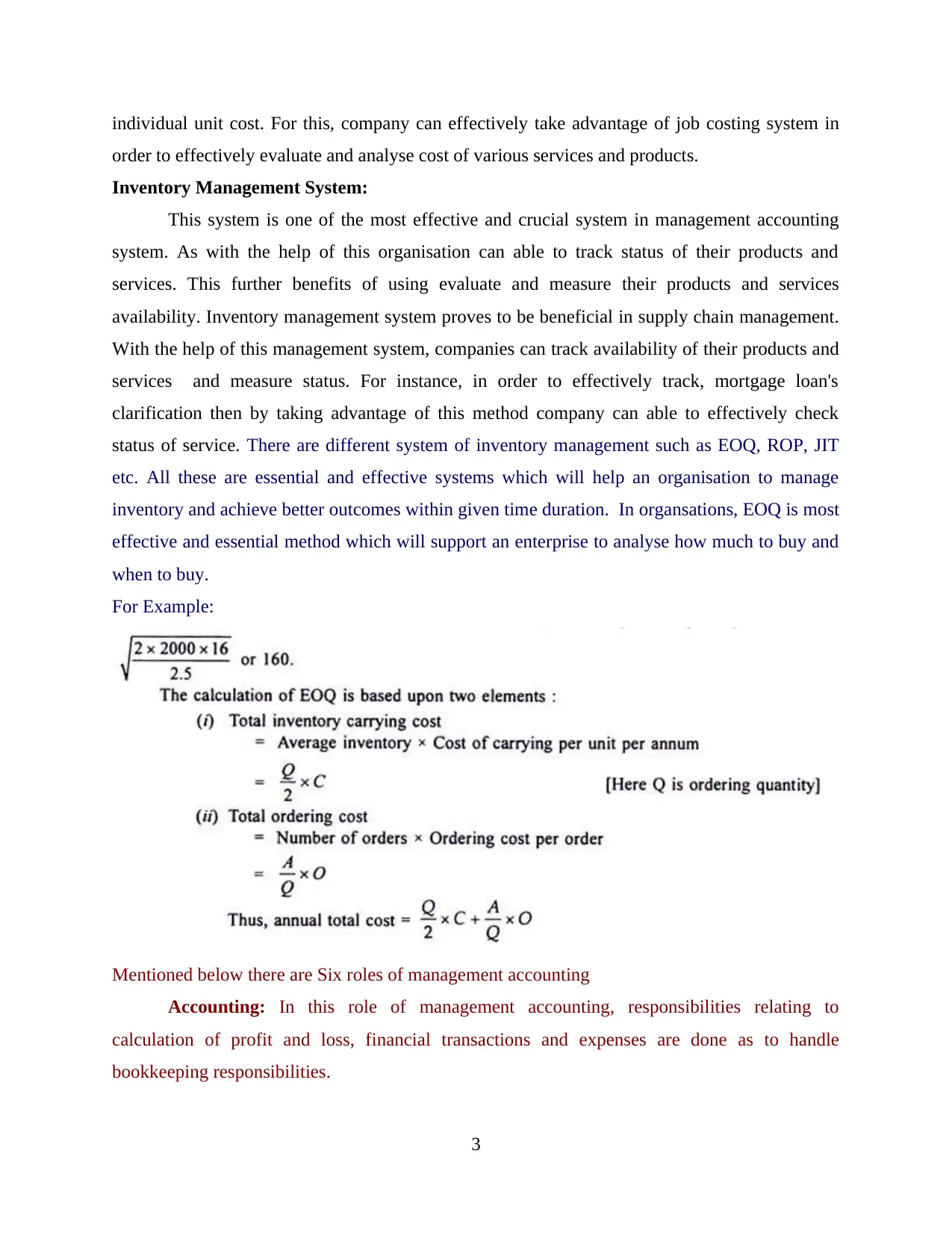
individual unit cost. For this, company can effectively take advantage of job costing system in
order to effectively evaluate and analyse cost of various services and products.
Inventory Management System:
This system is one of the most effective and crucial system in management accounting
system. As with the help of this organisation can able to track status of their products and
services. This further benefits of using evaluate and measure their products and services
availability. Inventory management system proves to be beneficial in supply chain management.
With the help of this management system, companies can track availability of their products and
services and measure status. For instance, in order to effectively track, mortgage loan's
clarification then by taking advantage of this method company can able to effectively check
status of service. There are different system of inventory management such as EOQ, ROP, JIT
etc. All these are essential and effective systems which will help an organisation to manage
inventory and achieve better outcomes within given time duration. In organsations, EOQ is most
effective and essential method which will support an enterprise to analyse how much to buy and
when to buy.
For Example:
Mentioned below there are Six roles of management accounting
Accounting: In this role of management accounting, responsibilities relating to
calculation of profit and loss, financial transactions and expenses are done as to handle
bookkeeping responsibilities.
3
order to effectively evaluate and analyse cost of various services and products.
Inventory Management System:
This system is one of the most effective and crucial system in management accounting
system. As with the help of this organisation can able to track status of their products and
services. This further benefits of using evaluate and measure their products and services
availability. Inventory management system proves to be beneficial in supply chain management.
With the help of this management system, companies can track availability of their products and
services and measure status. For instance, in order to effectively track, mortgage loan's
clarification then by taking advantage of this method company can able to effectively check
status of service. There are different system of inventory management such as EOQ, ROP, JIT
etc. All these are essential and effective systems which will help an organisation to manage
inventory and achieve better outcomes within given time duration. In organsations, EOQ is most
effective and essential method which will support an enterprise to analyse how much to buy and
when to buy.
For Example:
Mentioned below there are Six roles of management accounting
Accounting: In this role of management accounting, responsibilities relating to
calculation of profit and loss, financial transactions and expenses are done as to handle
bookkeeping responsibilities.
3
⊘ This is a preview!⊘
Do you want full access?
Subscribe today to unlock all pages.

Trusted by 1+ million students worldwide
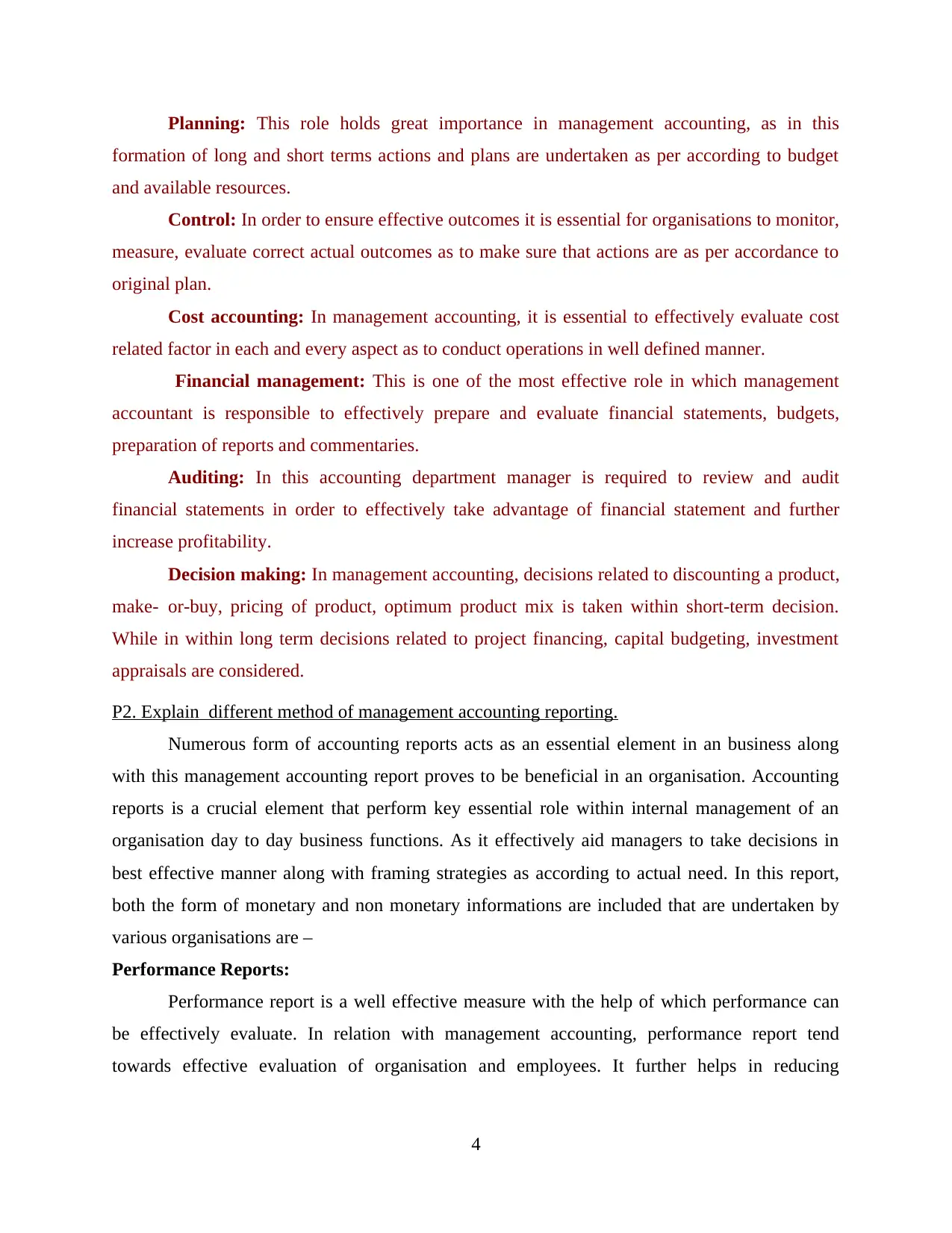
Planning: This role holds great importance in management accounting, as in this
formation of long and short terms actions and plans are undertaken as per according to budget
and available resources.
Control: In order to ensure effective outcomes it is essential for organisations to monitor,
measure, evaluate correct actual outcomes as to make sure that actions are as per accordance to
original plan.
Cost accounting: In management accounting, it is essential to effectively evaluate cost
related factor in each and every aspect as to conduct operations in well defined manner.
Financial management: This is one of the most effective role in which management
accountant is responsible to effectively prepare and evaluate financial statements, budgets,
preparation of reports and commentaries.
Auditing: In this accounting department manager is required to review and audit
financial statements in order to effectively take advantage of financial statement and further
increase profitability.
Decision making: In management accounting, decisions related to discounting a product,
make- or-buy, pricing of product, optimum product mix is taken within short-term decision.
While in within long term decisions related to project financing, capital budgeting, investment
appraisals are considered.
P2. Explain different method of management accounting reporting.
Numerous form of accounting reports acts as an essential element in an business along
with this management accounting report proves to be beneficial in an organisation. Accounting
reports is a crucial element that perform key essential role within internal management of an
organisation day to day business functions. As it effectively aid managers to take decisions in
best effective manner along with framing strategies as according to actual need. In this report,
both the form of monetary and non monetary informations are included that are undertaken by
various organisations are –
Performance Reports:
Performance report is a well effective measure with the help of which performance can
be effectively evaluate. In relation with management accounting, performance report tend
towards effective evaluation of organisation and employees. It further helps in reducing
4
formation of long and short terms actions and plans are undertaken as per according to budget
and available resources.
Control: In order to ensure effective outcomes it is essential for organisations to monitor,
measure, evaluate correct actual outcomes as to make sure that actions are as per accordance to
original plan.
Cost accounting: In management accounting, it is essential to effectively evaluate cost
related factor in each and every aspect as to conduct operations in well defined manner.
Financial management: This is one of the most effective role in which management
accountant is responsible to effectively prepare and evaluate financial statements, budgets,
preparation of reports and commentaries.
Auditing: In this accounting department manager is required to review and audit
financial statements in order to effectively take advantage of financial statement and further
increase profitability.
Decision making: In management accounting, decisions related to discounting a product,
make- or-buy, pricing of product, optimum product mix is taken within short-term decision.
While in within long term decisions related to project financing, capital budgeting, investment
appraisals are considered.
P2. Explain different method of management accounting reporting.
Numerous form of accounting reports acts as an essential element in an business along
with this management accounting report proves to be beneficial in an organisation. Accounting
reports is a crucial element that perform key essential role within internal management of an
organisation day to day business functions. As it effectively aid managers to take decisions in
best effective manner along with framing strategies as according to actual need. In this report,
both the form of monetary and non monetary informations are included that are undertaken by
various organisations are –
Performance Reports:
Performance report is a well effective measure with the help of which performance can
be effectively evaluate. In relation with management accounting, performance report tend
towards effective evaluation of organisation and employees. It further helps in reducing
4
Paraphrase This Document
Need a fresh take? Get an instant paraphrase of this document with our AI Paraphraser
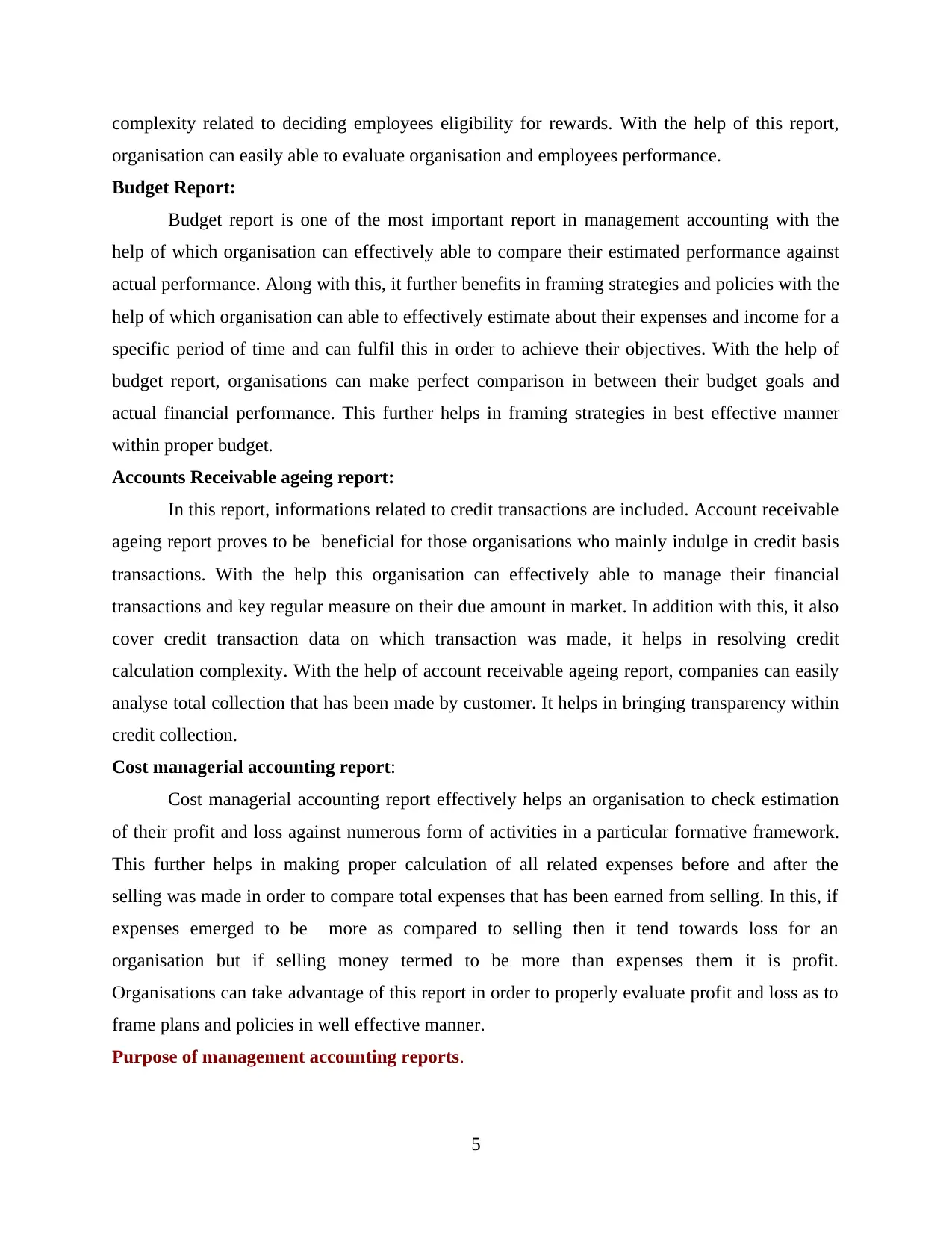
complexity related to deciding employees eligibility for rewards. With the help of this report,
organisation can easily able to evaluate organisation and employees performance.
Budget Report:
Budget report is one of the most important report in management accounting with the
help of which organisation can effectively able to compare their estimated performance against
actual performance. Along with this, it further benefits in framing strategies and policies with the
help of which organisation can able to effectively estimate about their expenses and income for a
specific period of time and can fulfil this in order to achieve their objectives. With the help of
budget report, organisations can make perfect comparison in between their budget goals and
actual financial performance. This further helps in framing strategies in best effective manner
within proper budget.
Accounts Receivable ageing report:
In this report, informations related to credit transactions are included. Account receivable
ageing report proves to be beneficial for those organisations who mainly indulge in credit basis
transactions. With the help this organisation can effectively able to manage their financial
transactions and key regular measure on their due amount in market. In addition with this, it also
cover credit transaction data on which transaction was made, it helps in resolving credit
calculation complexity. With the help of account receivable ageing report, companies can easily
analyse total collection that has been made by customer. It helps in bringing transparency within
credit collection.
Cost managerial accounting report:
Cost managerial accounting report effectively helps an organisation to check estimation
of their profit and loss against numerous form of activities in a particular formative framework.
This further helps in making proper calculation of all related expenses before and after the
selling was made in order to compare total expenses that has been earned from selling. In this, if
expenses emerged to be more as compared to selling then it tend towards loss for an
organisation but if selling money termed to be more than expenses them it is profit.
Organisations can take advantage of this report in order to properly evaluate profit and loss as to
frame plans and policies in well effective manner.
Purpose of management accounting reports.
5
organisation can easily able to evaluate organisation and employees performance.
Budget Report:
Budget report is one of the most important report in management accounting with the
help of which organisation can effectively able to compare their estimated performance against
actual performance. Along with this, it further benefits in framing strategies and policies with the
help of which organisation can able to effectively estimate about their expenses and income for a
specific period of time and can fulfil this in order to achieve their objectives. With the help of
budget report, organisations can make perfect comparison in between their budget goals and
actual financial performance. This further helps in framing strategies in best effective manner
within proper budget.
Accounts Receivable ageing report:
In this report, informations related to credit transactions are included. Account receivable
ageing report proves to be beneficial for those organisations who mainly indulge in credit basis
transactions. With the help this organisation can effectively able to manage their financial
transactions and key regular measure on their due amount in market. In addition with this, it also
cover credit transaction data on which transaction was made, it helps in resolving credit
calculation complexity. With the help of account receivable ageing report, companies can easily
analyse total collection that has been made by customer. It helps in bringing transparency within
credit collection.
Cost managerial accounting report:
Cost managerial accounting report effectively helps an organisation to check estimation
of their profit and loss against numerous form of activities in a particular formative framework.
This further helps in making proper calculation of all related expenses before and after the
selling was made in order to compare total expenses that has been earned from selling. In this, if
expenses emerged to be more as compared to selling then it tend towards loss for an
organisation but if selling money termed to be more than expenses them it is profit.
Organisations can take advantage of this report in order to properly evaluate profit and loss as to
frame plans and policies in well effective manner.
Purpose of management accounting reports.
5
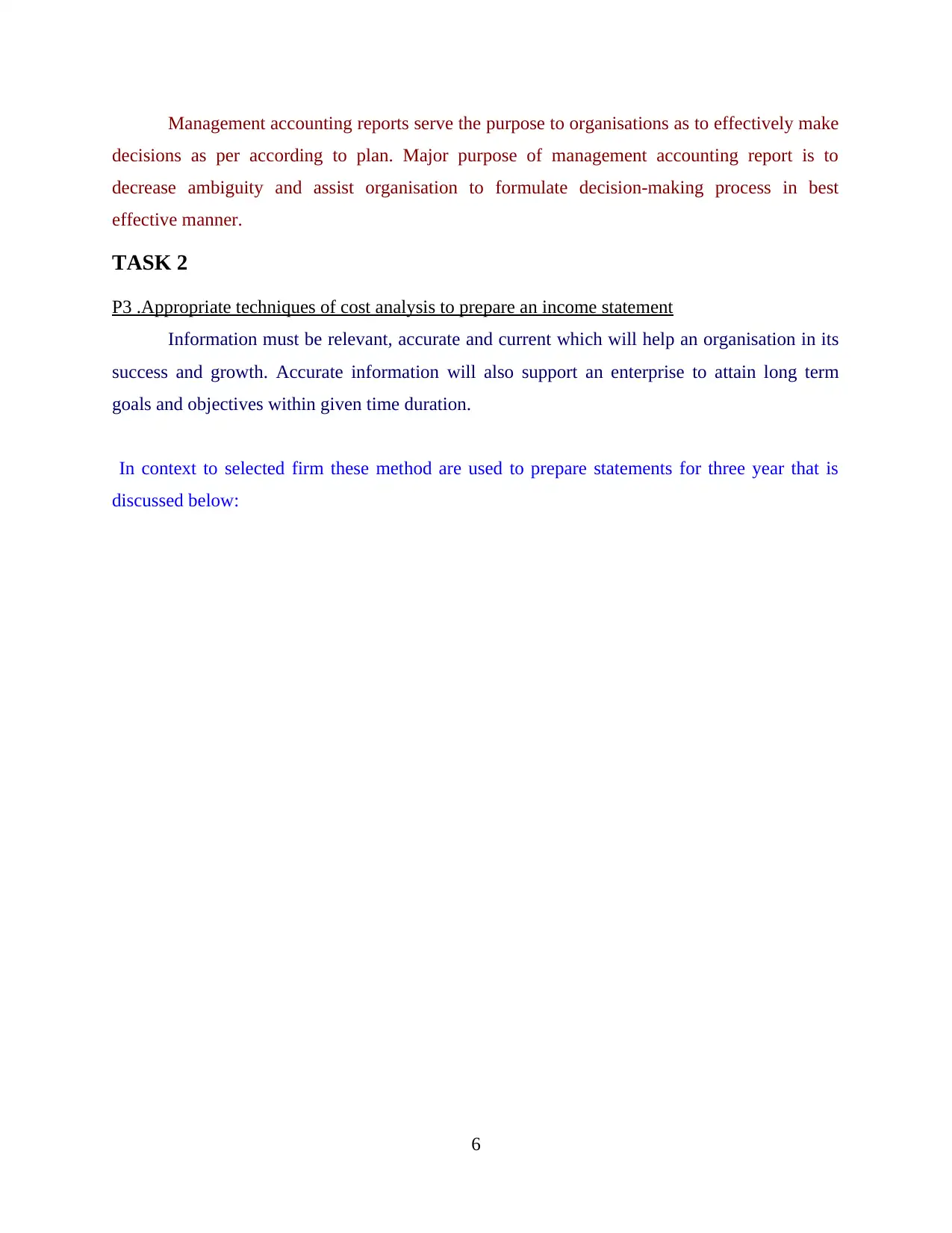
Management accounting reports serve the purpose to organisations as to effectively make
decisions as per according to plan. Major purpose of management accounting report is to
decrease ambiguity and assist organisation to formulate decision-making process in best
effective manner.
TASK 2
P3 .Appropriate techniques of cost analysis to prepare an income statement
Information must be relevant, accurate and current which will help an organisation in its
success and growth. Accurate information will also support an enterprise to attain long term
goals and objectives within given time duration.
In context to selected firm these method are used to prepare statements for three year that is
discussed below:
6
decisions as per according to plan. Major purpose of management accounting report is to
decrease ambiguity and assist organisation to formulate decision-making process in best
effective manner.
TASK 2
P3 .Appropriate techniques of cost analysis to prepare an income statement
Information must be relevant, accurate and current which will help an organisation in its
success and growth. Accurate information will also support an enterprise to attain long term
goals and objectives within given time duration.
In context to selected firm these method are used to prepare statements for three year that is
discussed below:
6
⊘ This is a preview!⊘
Do you want full access?
Subscribe today to unlock all pages.

Trusted by 1+ million students worldwide
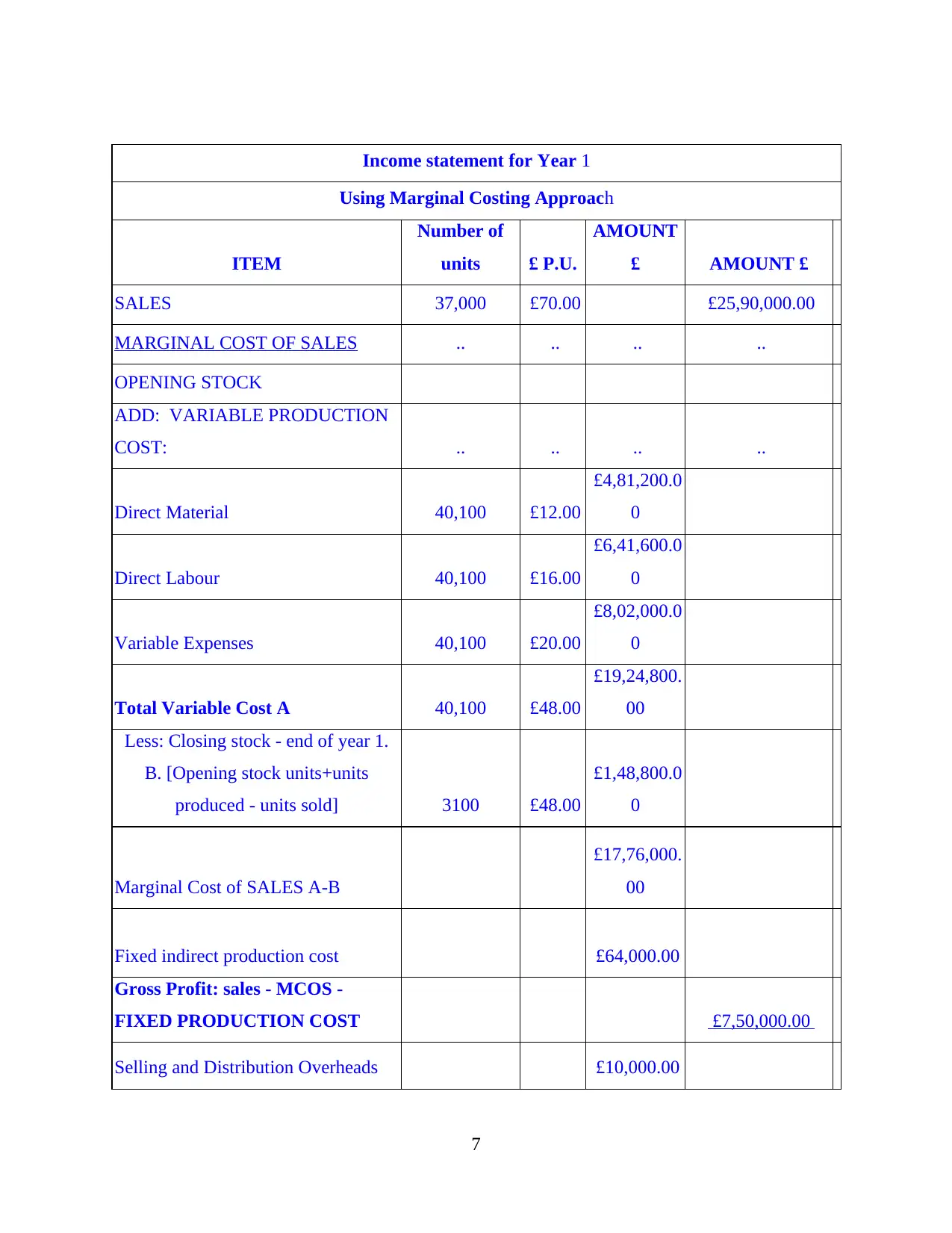
Income statement for Year 1
Using Marginal Costing Approach
ITEM
Number of
units £ P.U.
AMOUNT
£ AMOUNT £
SALES 37,000 £70.00 £25,90,000.00
MARGINAL COST OF SALES .. .. .. ..
OPENING STOCK
ADD: VARIABLE PRODUCTION
COST: .. .. .. ..
Direct Material 40,100 £12.00
£4,81,200.0
0
Direct Labour 40,100 £16.00
£6,41,600.0
0
Variable Expenses 40,100 £20.00
£8,02,000.0
0
Total Variable Cost A 40,100 £48.00
£19,24,800.
00
Less: Closing stock - end of year 1.
B. [Opening stock units+units
produced - units sold] 3100 £48.00
£1,48,800.0
0
Marginal Cost of SALES A-B
£17,76,000.
00
Fixed indirect production cost £64,000.00
Gross Profit: sales - MCOS -
FIXED PRODUCTION COST £7,50,000.00
Selling and Distribution Overheads £10,000.00
7
Using Marginal Costing Approach
ITEM
Number of
units £ P.U.
AMOUNT
£ AMOUNT £
SALES 37,000 £70.00 £25,90,000.00
MARGINAL COST OF SALES .. .. .. ..
OPENING STOCK
ADD: VARIABLE PRODUCTION
COST: .. .. .. ..
Direct Material 40,100 £12.00
£4,81,200.0
0
Direct Labour 40,100 £16.00
£6,41,600.0
0
Variable Expenses 40,100 £20.00
£8,02,000.0
0
Total Variable Cost A 40,100 £48.00
£19,24,800.
00
Less: Closing stock - end of year 1.
B. [Opening stock units+units
produced - units sold] 3100 £48.00
£1,48,800.0
0
Marginal Cost of SALES A-B
£17,76,000.
00
Fixed indirect production cost £64,000.00
Gross Profit: sales - MCOS -
FIXED PRODUCTION COST £7,50,000.00
Selling and Distribution Overheads £10,000.00
7
Paraphrase This Document
Need a fresh take? Get an instant paraphrase of this document with our AI Paraphraser
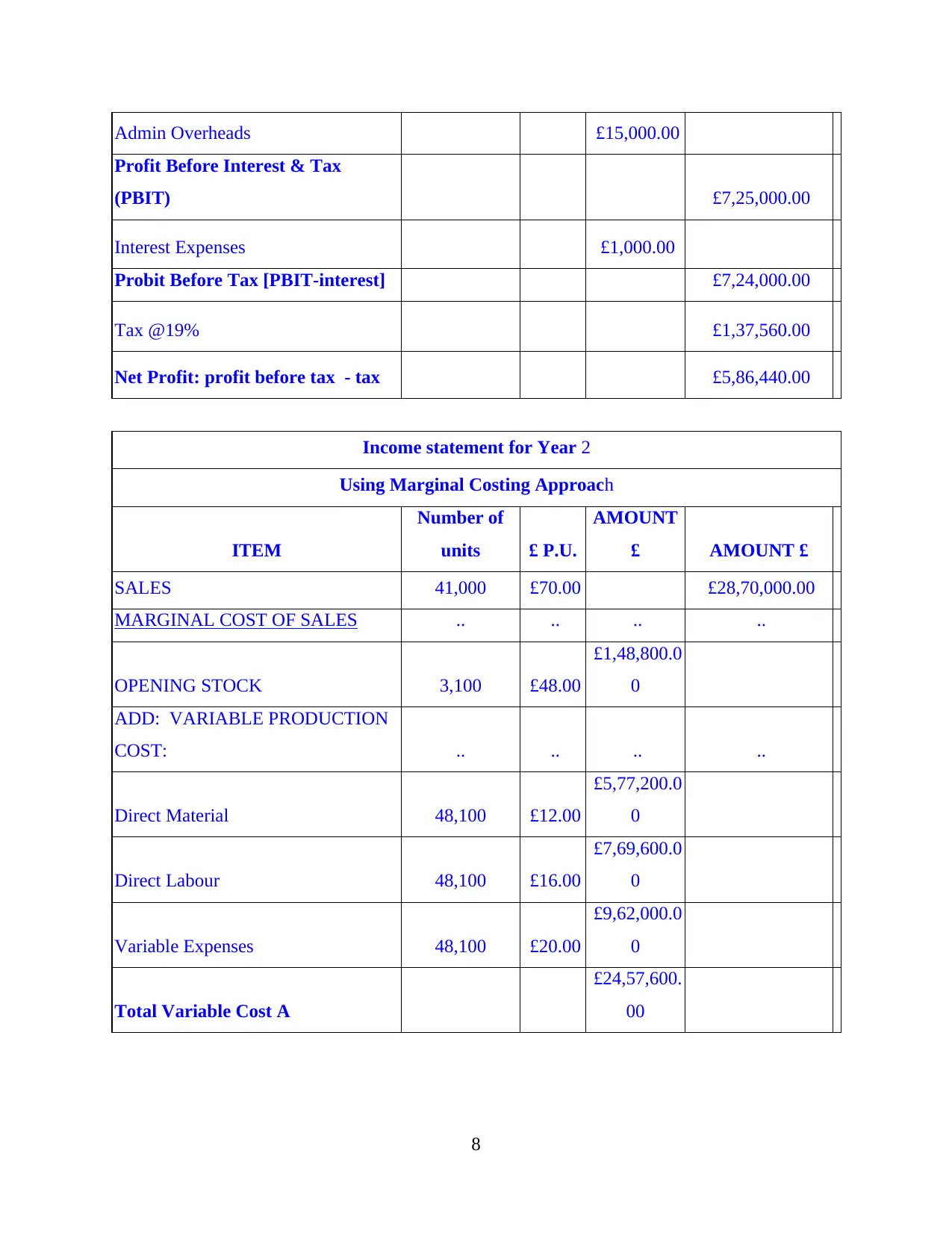
Admin Overheads £15,000.00
Profit Before Interest & Tax
(PBIT) £7,25,000.00
Interest Expenses £1,000.00
Probit Before Tax [PBIT-interest] £7,24,000.00
Tax @19% £1,37,560.00
Net Profit: profit before tax - tax £5,86,440.00
Income statement for Year 2
Using Marginal Costing Approach
ITEM
Number of
units £ P.U.
AMOUNT
£ AMOUNT £
SALES 41,000 £70.00 £28,70,000.00
MARGINAL COST OF SALES .. .. .. ..
OPENING STOCK 3,100 £48.00
£1,48,800.0
0
ADD: VARIABLE PRODUCTION
COST: .. .. .. ..
Direct Material 48,100 £12.00
£5,77,200.0
0
Direct Labour 48,100 £16.00
£7,69,600.0
0
Variable Expenses 48,100 £20.00
£9,62,000.0
0
Total Variable Cost A
£24,57,600.
00
8
Profit Before Interest & Tax
(PBIT) £7,25,000.00
Interest Expenses £1,000.00
Probit Before Tax [PBIT-interest] £7,24,000.00
Tax @19% £1,37,560.00
Net Profit: profit before tax - tax £5,86,440.00
Income statement for Year 2
Using Marginal Costing Approach
ITEM
Number of
units £ P.U.
AMOUNT
£ AMOUNT £
SALES 41,000 £70.00 £28,70,000.00
MARGINAL COST OF SALES .. .. .. ..
OPENING STOCK 3,100 £48.00
£1,48,800.0
0
ADD: VARIABLE PRODUCTION
COST: .. .. .. ..
Direct Material 48,100 £12.00
£5,77,200.0
0
Direct Labour 48,100 £16.00
£7,69,600.0
0
Variable Expenses 48,100 £20.00
£9,62,000.0
0
Total Variable Cost A
£24,57,600.
00
8
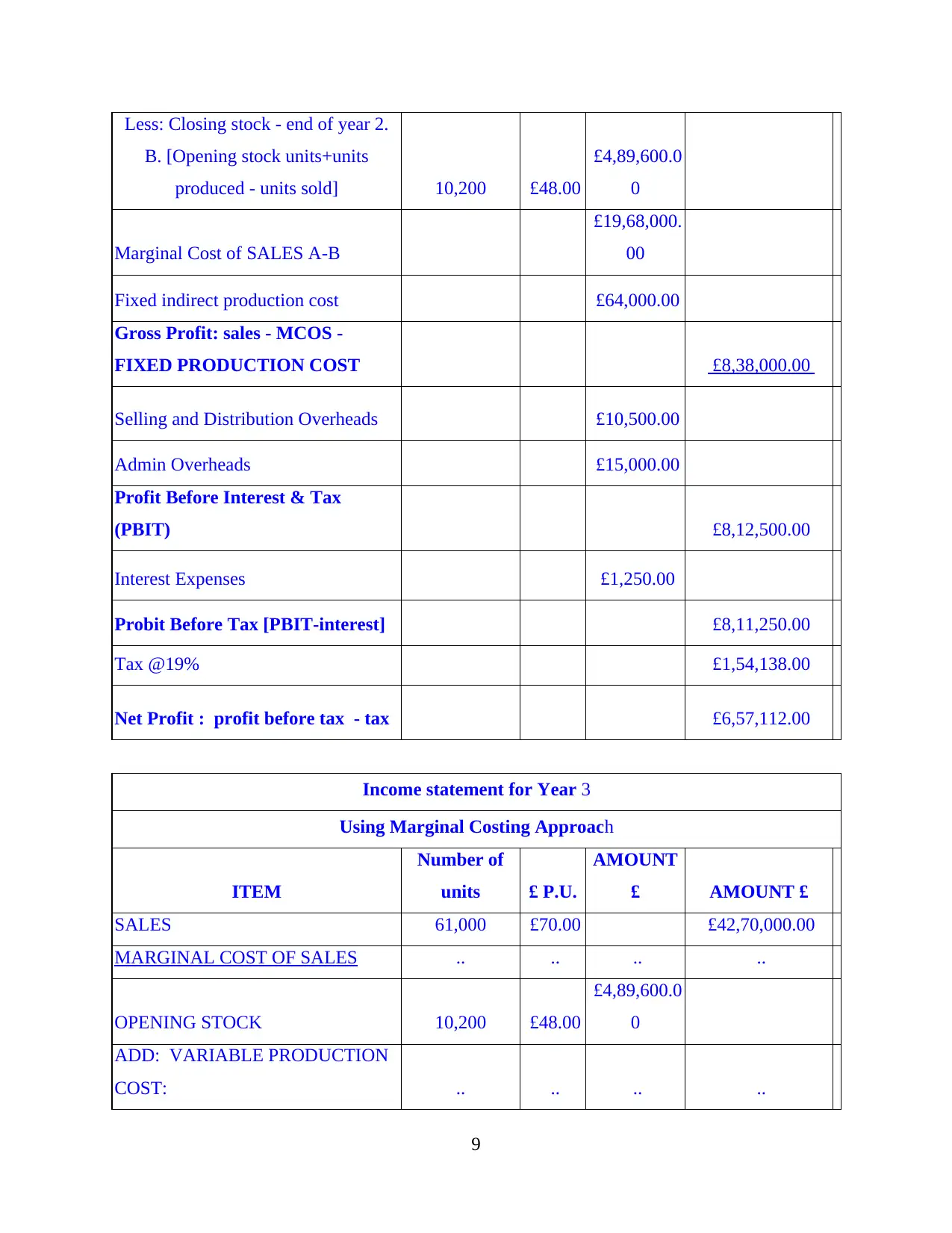
Less: Closing stock - end of year 2.
B. [Opening stock units+units
produced - units sold] 10,200 £48.00
£4,89,600.0
0
Marginal Cost of SALES A-B
£19,68,000.
00
Fixed indirect production cost £64,000.00
Gross Profit: sales - MCOS -
FIXED PRODUCTION COST £8,38,000.00
Selling and Distribution Overheads £10,500.00
Admin Overheads £15,000.00
Profit Before Interest & Tax
(PBIT) £8,12,500.00
Interest Expenses £1,250.00
Probit Before Tax [PBIT-interest] £8,11,250.00
Tax @19% £1,54,138.00
Net Profit : profit before tax - tax £6,57,112.00
Income statement for Year 3
Using Marginal Costing Approach
ITEM
Number of
units £ P.U.
AMOUNT
£ AMOUNT £
SALES 61,000 £70.00 £42,70,000.00
MARGINAL COST OF SALES .. .. .. ..
OPENING STOCK 10,200 £48.00
£4,89,600.0
0
ADD: VARIABLE PRODUCTION
COST: .. .. .. ..
9
B. [Opening stock units+units
produced - units sold] 10,200 £48.00
£4,89,600.0
0
Marginal Cost of SALES A-B
£19,68,000.
00
Fixed indirect production cost £64,000.00
Gross Profit: sales - MCOS -
FIXED PRODUCTION COST £8,38,000.00
Selling and Distribution Overheads £10,500.00
Admin Overheads £15,000.00
Profit Before Interest & Tax
(PBIT) £8,12,500.00
Interest Expenses £1,250.00
Probit Before Tax [PBIT-interest] £8,11,250.00
Tax @19% £1,54,138.00
Net Profit : profit before tax - tax £6,57,112.00
Income statement for Year 3
Using Marginal Costing Approach
ITEM
Number of
units £ P.U.
AMOUNT
£ AMOUNT £
SALES 61,000 £70.00 £42,70,000.00
MARGINAL COST OF SALES .. .. .. ..
OPENING STOCK 10,200 £48.00
£4,89,600.0
0
ADD: VARIABLE PRODUCTION
COST: .. .. .. ..
9
⊘ This is a preview!⊘
Do you want full access?
Subscribe today to unlock all pages.

Trusted by 1+ million students worldwide
1 out of 27
Related Documents
Your All-in-One AI-Powered Toolkit for Academic Success.
+13062052269
info@desklib.com
Available 24*7 on WhatsApp / Email
![[object Object]](/_next/static/media/star-bottom.7253800d.svg)
Unlock your academic potential
Copyright © 2020–2025 A2Z Services. All Rights Reserved. Developed and managed by ZUCOL.





